We love what you do, it is why we want to hire you.
But if you come and work for us, we want you to stop doing it.
Somebody needs to think about this stuff...
by justin
We love what you do, it is why we want to hire you.
But if you come and work for us, we want you to stop doing it.
by justin
Today I finished reading “Looking for Group #4” by Ryan Sohmer
by justin
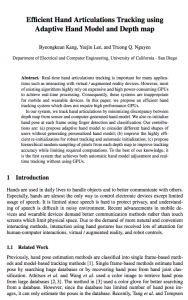
Efficient Hand Articulations Tracking using Adaptive Hand Model and Depth map
Today I read a published paper “Efficient Hand Articulations Tracking using Adaptive Hand Model and Depth map”
The abstract is:
Real-time hand articulations tracking is important for many applications such as interacting with virtual / augmented reality devices or tablets. However, most of existing algorithms highly rely on expensive and high power-consuming GPUs to achieve real-time processing. Consequently, these systems are inappropriate for mobile and wearable devices. In this paper, we propose an efficient hand tracking system which does not require high performance GPUs. In our system, we track hand articulations by minimizing discrepancy between depth map from sensor and computer-generated hand model. We also initialize hand pose at each frame using finger detection and classification. Our contributions are: (a) propose adaptive hand model to consider different hand shapes of users without generating personalized hand model; (b) improve the highly efficient frame initialization for robust tracking and automatic initialization; (c) propose hierarchical random sampling of pixels from each depth map to improve tracking accuracy while limiting required computations. To the best of our knowledge, it is the first system that achieves both automatic hand model adjustment and real-time tracking without using GPUs.
by justin
The reason that I am good with kids is because by the end of the day I always make sure to give them back to their parents.
I’m the cool uncle/friend of family that just does the fun (and sometimes dangerous) stuff.
And we don’t have to clean up afterwards.
Now I understand why grandparents are loved so much.
by justin
Today I finished reading “Looking for Group #3” by Ryan Sohmer
by justin

Low-cost Augmented Reality prototype for controlling network devices
Today I read a published paper “Low-cost Augmented Reality prototype for controlling network devices”
The abstract is:
With the evolution of mobile devices, and smart-phones in particular, comes the ability to create new experiences that enhance the way we see, interact, and manipulate objects, within the world that surrounds us. It is now possible to blend data from our senses and our devices in numerous ways that simply were not possible before using Augmented Reality technology. In a near future, when all of the office devices as well as your personal electronic gadgets are on a common wireless network, operating them using a universal remote controller would be possible. This paper presents an off-the-shelf, low-cost prototype that leverages the Augmented Reality technology to deliver a novel and interactive way of operating office network devices around using a mobile device. We believe this type of system may provide benefits to controlling multiple integrated devices and visualizing interconnectivity or utilizing visual elements to pass information from one device to another, or may be especially beneficial to control devices when interacting with them physically may be difficult or pose danger or harm.
by justin
This month I am studying “Languages.”
This is a rather generic title for “I’m just going to do a self-directed, self-study of spoken language.”
Looks like my bakery certification will wait yet another month as I had to take a month off from studying my baking coursework due to actual, paying work on-site in Menlo Park.
Making use of the Duolingo website to brush up on French, German and Welsh.
1 month of self-paced, self-directed study on DuoLingo
Just a month, nothing more
Update: Got through a good chunk of the courseware for French, German, Welsh, Esperanto, Spanish and Italian.
My DuoLingo profile is here: https://www.duolingo.com/JustinRLloyd
Managed to log 35 hours of language study and practice.
by justin

This week I am listening to “American Beauty/American Psycho” by Fall Out Boy
by justin

Today I watched “13 Assassins”
Stylistically violent period film. Incredible story driven narrative that provides another level beyond just lots of grotesque sword play, maiming and dismemberment. Several shocking scenes.
by justin
Potential Client: “We’d like to bring you in for an all-day technical interview to make sure you can do the work.”
Me: “Sorry, swamped with too much paying work to give any time to your college hazing rituals. Go find yourself a recent college grad willing to put up with that.”
by justin
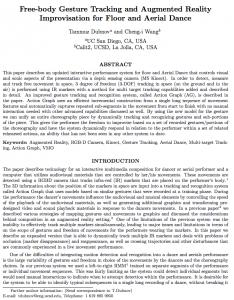
Free-body Gesture Tracking and Augmented Reality Improvisation for Floor and Aerial Dance
Today I read a published paper “Free-body Gesture Tracking and Augmented Reality Improvisation for Floor and Aerial Dance”
The abstract is:
This paper describes an updated interactive performance system for floor and Aerial Dance that controls visual and sonic aspects of the presentation via a depth sensing camera (MS Kinect). In order to detect, measure and track free movement in space, 3 degree of freedom (3-DOF) tracking in space (on the ground and in the air) is performed using IR markers with a method for multi target tracking capabilities added and described in detail. An improved gesture tracking and recognition system, called Action Graph (AG), is described in the paper. Action Graph uses an efficient incremental construction from a single long sequence of movement features and automatically captures repeated sub-segments in the movement from start to finish with no manual interaction needed with other advanced capabilities discussed as well. By using the new model for the gesture we can unify an entire choreography piece by dynamically tracking and recognizing gestures and sub-portions of the piece. This gives the performer the freedom to improvise based on a set of recorded gestures/portions of the choreography and have the system dynamically respond in relation to the performer within a set of related rehearsed actions, an ability that has not been seen in any other system to date.
by justin

Free-body Gesture Tracking and Augmented Reality Improvisation for Floor and Aerial Dance
Today I read a published paper titled “Free-body Gesture Tracking and Augmented Reality Improvisation for Floor and Aerial Dance”
Thought it was a rather novel application for a Microsoft Kinect. Not sure if I will ever apply any of the content to my own work. But still an interesting read.
The abstract is:
This paper describes an updated interactive performance system for floor and Aerial Dance that controls visual and sonic aspects of the presentation via a depth sensing camera (MS Kinect). In order to detect, measure and track free movement in space, 3 degree of freedom (3-DOF) tracking in space (on the ground and in the air) is performed using IR markers with a method for multi target tracking capabilities added and described in detail. An improved gesture tracking and recognition system, called Action Graph (AG), is described in the paper. Action Graph uses an efficient incremental construction from a single long sequence of movement features and automatically captures repeated sub-segments in the movement from start to finish with no manual interaction needed with other advanced capabilities discussed as well. By using the new model for the gesture we can unify an entire choreography piece by dynamically tracking and recognizing gestures and sub-portions of the piece. This gives the performer the freedom to improvise based on a set of recorded gestures/portions of the choreography and have the system dynamically respond in relation to the performer within a set of related rehearsed actions, an ability that has not been seen in any other system to date.
by justin
No passwords – no saved games – no mercy.
Gaming eighties-style.
We reduce the friction to capture a larger audience. But we lose an essential quality due to that transition.
by justin
Raspberry Pi dead.
Blew out the power regulators.
Gotta love that certain, quintessential smell that says “You done screwed up, boy!”
I needed an excuse to pop down to the local electronics shack and pick up some replacements.
by justin
Today I finished reading “Running Lean: Iterate from Plan A to a Plan That Works” by Ash Maurya
by justin
Just spent 2 hours trying to figure out why After Effects was complaining that my project files were corrupted.
When it turned out to be a permissions error.
*sigh* So not a helpful error message.
by justin
Well this is interesting…
“As a software developer yourself, don’t you think it is hypocritical to steal someone else’s software? You’re running this WordPress plugin, licensed for only a single website, on multiple blogs. You’re committing piracy.”
“GPL source code” I responded.
“This is a commercial WordPress plugin and theme, you have to pay all the licensing fees.”
“Perhaps you don’t understand what GPL means.” I countered.
“I know what it means! It doesn’t apply here! You’re ripping these guys off!”
“GPL still applies.” I countered again.
by justin
Today I finished reading “The Art of the Start 2.0: The Time-Tested, Battle-Hardened Guide for Anyone Starting Anything” by Guy Kawasaki
by justin
Jesus may love you but the Lloyd doesn’t have to.
by justin

This week I am listening to “Coin Coin Chapter Three: River Run Thee” by Matana Roberts
by justin
I really should take the career advice of completely random internet dweebs that message me out of the blue.
I am sure my life would be just perfect if only I would listen to every idiot with an opinion.
by justin
It is amazing to me what you can purchase through Amazon.
I just ordered:
Expected delivery is tomorrow morning.
Mind.
Blown.
by justin
Multiplying your matrices in the wrong order is the mathematical equivalent of looking for the missing semi-colon in your code.
by justin
Multiboxing World of Warcraft again.
Just kicked the living excrement out of Lich King and did it at level.
Proud achievement.
In other news, it is practically impossible to kill 10 Shamans.
by justin
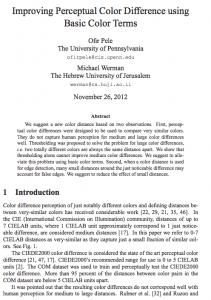
Improving Perceptual Color Difference using Basic Color Terms
Today I read a published paper “Improving Perceptual Color Difference using Basic Color Terms”
The abstract is:
We suggest a new color distance based on two observations. First, perceptual color differences were designed to be used to compare very similar colors. They do not capture human perception for medium and large color differences well. Thresholding was proposed to solve the problem for large color differences, i.e. two totally different colors are always the same distance apart. We show that thresholding alone cannot improve medium color differences. We suggest to alleviate this problem using basic color terms. Second, when a color distance is used for edge detection, many small distances around the just noticeable difference may account for false edges. We suggest to reduce the effect of small distances.
by justin
Building a pillow fort – because I can!
Every office needs a pillow fort.
by justin

This week I am listening to “Rodeo” by Travi$ Scott
by justin
I am re-reading “The Mythical Man Month” by Brooks.
The last time I read this was 1984 and I was 17 years old and had been developing software for about six years by then (and of course thought I knew it all).
It is one of those rare books about technology and software projects that is still highly relevant.
What I find interesting is my perspective on the book has shifted since I first read it.
I have gained a lot of experience in the intervening 30 years and I am looking on the examples given in the book not just from the perspective of a software developer but also a software developer that was influenced by the book 30 years ago and how my attitudes towards the book have changed.
Just got done re-reading “The Mythical Man Month” by Brooks.
In the intervening 30 years since I originally read the book, my conclusion now is that Brooks was overly-optimistic.
by justin
If you are going to ask me to lunch to pick my brains, and bring along your two business partners, and spend three hours exploring my brains, could you perhaps pay for my lunch?
Professional etiquette: It’s not just for other people.
The clincher was that after two hours, nobody had yet reached for the check. I eventually had to throw down a twenty to cover my $9 lunch salad and small bottle of water.
by justin
“We can’t give you access to the database because that would pose a security risk and expose all of our customer data to you.”
Instead, I was provided with an SQL dump, attached to an email in plain text, with all of the user accounts, passwords and credit card numbers stored un-encrypted.
Perhaps they were thinking of a different security risk I am not aware of.
by justin
Sheesh! Beancounters!
It’s never how much profit you made for the company.
It’s never how much you saved the company.
It is always how much you spent.
“You paid $1.93 more for lunch than you were authorised, we cannot approve this expense.”
Yeah, and I saved you $2,500 by inconveniencing myself and driving to the client location instead of flying and I didn’t get paid for those hours of travel. I used my own hotel points instead of paying for the hotel and I closed a $70,000 deal.
But all you care about is the fact I spent $1.93 more on lunch than the approved $12.
*This* is why I don’t like dealing with expense reports.
by justin
During a technical interview from my past: “So dictate the code over the phone of how you would solve this algorithm and I’ll tell you whether you are correct.”
Ummm… how about no?
by justin

This week I am listening to “What Went Down” by Foals
by justin
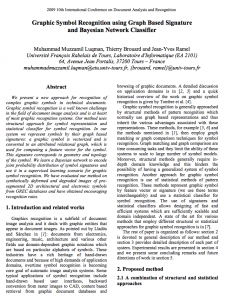
Graphic Symbol Recognition using Graph Based Signature and Bayesian Network Classifier
Today I read a published paper titled “Graphic Symbol Recognition using Graph Based Signature and Bayesian Network Classifier”
Interesting combination of a relational graph and a Bayesian network to recognise non-alphanumeric symbols in technical documents. As this is a reasonably hard problem to solve (or it was when I was doing that sort of thing about 20 years ago) it is encouraging to read new approaches (new for me anyway) to the problem. I wish the recognition rates (acknowledged in the paper) were a little higher.
The abstract:
We present a new approach for recognition of complex graphic symbols in technical documents. Graphic symbol recognition is a well known challenge in the field of document image analysis and is at heart of most graphic recognition systems. Our method uses structural approach for symbol representation and statistical classifier for symbol recognition. In our system we represent symbols by their graph based signatures: a graphic symbol is vectorized and is converted to an attributed relational graph, which is used for computing a feature vector for the symbol. This signature corresponds to geometry and topology of the symbol. We learn a Bayesian network to encode joint probability distribution of symbol signatures and use it in a supervised learning scenario for graphic symbol recognition. We have evaluated our method on synthetically deformed and degraded images of pre-segmented 2D architectural and electronic symbols from GREC databases and have obtained encouraging recognition rates.
by justin
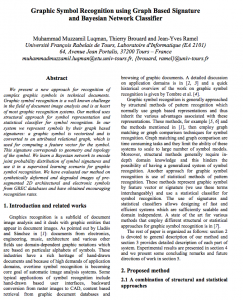
Graphic Symbol Recognition using Graph Based Signature and Bayesian Network Classifier
Today I read a published paper “Graphic Symbol Recognition using Graph Based Signature and Bayesian Network Classifier”
The abstract is:
We present a new approach for recognition of complex graphic symbols in technical documents. Graphic symbol recognition is a well known challenge in the field of document image analysis and is at heart of most graphic recognition systems. Our method uses structural approach for symbol representation and statistical classifier for symbol recognition. In our system we represent symbols by their graph based signatures: a graphic symbol is vectorized and is converted to an attributed relational graph, which is used for computing a feature vector for the symbol. This signature corresponds to geometry and topology of the symbol. We learn a Bayesian network to encode joint probability distribution of symbol signatures and use it in a supervised learning scenario for graphic symbol recognition. We have evaluated our method on synthetically deformed and degraded images of pre-segmented 2D architectural and electronic symbols from GREC databases and have obtained encouraging recognition rates.
by justin
“What we have here is a layer 8 issue, that is bleeding through in to layer 9. Seems the error code being generated has an ID of one zero Tango. That’s one of the more expensive problems to fix. We refer to it as a PICNIC.” says I.
“Why a PICNIC?” asks the client.
Without missing a beat, I retort, “You’ve heard of the problem P != NP complete? PICNIC is a useful acronym for remembering that. It’s a human factors issue.”
A few moments pass.
“Fantastic! When can you start?”
I think I just sold a steaming pile of BS.
by justin
Today I finished reading “Hello Startup. A Programmer’s Guide to Building Products, Technologies, and Teams” by Yevgeniy Brikman
by justin
Today I finished reading “Looking for Group #2” by Ryan Sohmer
by justin
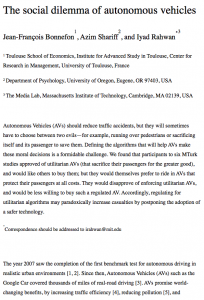
Autonomous Vehicles Need Experimental Ethics: Are We Ready for Utilitarian Cars?
Today I read a published paper “Autonomous Vehicles Need Experimental Ethics: Are We Ready for Utilitarian Cars?”
The abstract is:
The wide adoption of self-driving, Autonomous Vehicles (AVs) promises to dramatically reduce the number of traffic accidents. Some accidents, though, will be inevitable, because some situations will require AVs to choose the lesser of two evils. For example, running over a pedestrian on the road or a passer-by on the side; or choosing whether to run over a group of pedestrians or to sacrifice the passenger by driving into a wall. It is a formidable challenge to define the algorithms that will guide AVs confronted with such moral dilemmas. In particular, these moral algorithms will need to accomplish three potentially incompatible objectives: being consistent, not causing public outrage, and not discouraging buyers. We argue to achieve these objectives, manufacturers and regulators will need psychologists to apply the methods of experimental ethics to situations involving AVs and unavoidable harm. To illustrate our claim, we report three surveys showing that laypersons are relatively comfortable with utilitarian AVs, programmed to minimize the death toll in case of unavoidable harm. We give special attention to whether an AV should save lives by sacrificing its owner, and provide insights into (i) the perceived morality of this self-sacrifice, (ii) the willingness to see this self-sacrifice being legally enforced, (iii) the expectations that AVs will be programmed to self-sacrifice, and (iv) the willingness to buy self-sacrificing AVs.
by justin

This week I am listening to “I Love You, Honeybear” by Father John Misty
by justin
This month I am studying “Baking Mastery – Baking and pastry”
This is a 48 month part-time course which I am completing at about 2x the speed so far. This is the 23rd and 24th months of study.
At the end of this month I will complete the forth certificate.
Update: Work intruded, I have bumped my certificate application until end of next month.
Update: Logged 56 hours of study and practice over the month. 48 hours of expected class time for two months, plus an extra 8 hours of practice on my own.
by justin
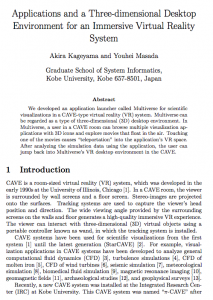
Applications and a Three-dimensional Desktop Environment for an Immersive Virtual Reality System
Today I read a published paper “Applications and a Three-dimensional Desktop Environment for an Immersive Virtual Reality System”
The abstract is:
We developed an application launcher called Multiverse for scientific visualizations in a CAVE-type virtual reality (VR) system. Multiverse can be regarded as a type of three-dimensional (3D) desktop environment. In Multiverse, a user in a CAVE room can browse multiple visualization applications with 3D icons and explore movies that float in the air. Touching one of the movies causes “teleportation” into the application’s VR space. After analyzing the simulation data using the application, the user can jump back into Multiverse’s VR desktop environment in the CAVE.
by justin
Potential Client (being very serious): “We were hoping for someone who had a bit more experience with developing games.”
P.S. I shipped my first video game in 1978, and they were aware of this.
by justin
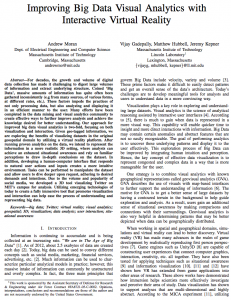
Improving Big Data Visual Analytics with Interactive Virtual Reality
Today I read a published paper “Improving Big Data Visual Analytics with Interactive Virtual Reality”
The abstract is:
For decades, the growth and volume of digital data collection has made it challenging to digest large volumes of information and extract underlying structure. Coined ‘Big Data’, massive amounts of information has quite often been gathered inconsistently (e.g from many sources, of various forms, at different rates, etc.). These factors impede the practices of not only processing data, but also analyzing and displaying it in an efficient manner to the user. Many efforts have been completed in the data mining and visual analytics community to create effective ways to further improve analysis and achieve the knowledge desired for better understanding. Our approach for improved big data visual analytics is two-fold, focusing on both visualization and interaction. Given geo-tagged information, we are exploring the benefits of visualizing datasets in the original geospatial domain by utilizing a virtual reality platform. After running proven analytics on the data, we intend to represent the information in a more realistic 3D setting, where analysts can achieve an enhanced situational awareness and rely on familiar perceptions to draw in-depth conclusions on the dataset. In addition, developing a human-computer interface that responds to natural user actions and inputs creates a more intuitive environment. Tasks can be performed to manipulate the dataset and allow users to dive deeper upon request, adhering to desired demands and intentions. Due to the volume and popularity of social media, we developed a 3D tool visualizing Twitter on MIT’s campus for analysis. Utilizing emerging technologies of today to create a fully immersive tool that promotes visualization and interaction can help ease the process of understanding and representing big data.
by justin
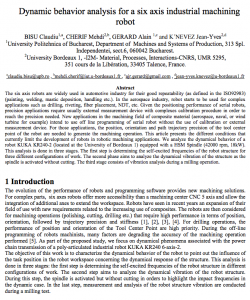
Dynamic behavior analysis for a six axis industrial machining robot
Today I read a published paper “Dynamic behavior analysis for a six axis industrial machining robot”
The abstract is:
The six axis robots are widely used in automotive industry for their good repeatability (as defined in the ISO92983) (painting, welding, mastic deposition, handling etc.). In the aerospace industry, robot starts to be used for complex applications such as drilling, riveting, fiber placement, NDT, etc. Given the positioning performance of serial robots, precision applications require usually external measurement device with complexes calibration procedure in order to reach the precision needed. New applications in the machining field of composite material (aerospace, naval, or wind turbine for example) intend to use off line programming of serial robot without the use of calibration or external measurement device. For those applications, the position, orientation and path trajectory precision of the tool center point of the robot are needed to generate the machining operation. This article presents the different conditions that currently limit the development of robots in robotic machining applications. We analyze the dynamical behavior of a robot KUKA KR240-2 (located at the University of Bordeaux 1) equipped with a HSM Spindle (42000 rpm, 18kW). This analysis is done in three stages. The first step is determining the self-excited frequencies of the robot structure for three different configurations of work. The second phase aims to analyze the dynamical vibration of the structure as the spindle is activated without cutting. The third stage consists of vibration analysis during a milling operation.
by justin
It is not an opinion, if you are right.
by justin
Why do you have so many separate blogs asked the person who was researching me.
“Because when I open a cook book I expect to see recipes, not a deeply interesting read on marketing your app in emerging markets and how to A/B test user acquisitions.” I replied.
by justin
Every man comes to the Lloyd in his own way.
by justin

This week I am listening to “Something More Than Free” by Jason Isbell
by justin
Imagine if every house in your neighbour triggered an hour long alarm every time someone walked past or approached the front door.
How annoying that would be.
I think we should just straight up outlaw car alarms.
Or make it so that they are only allowed to trigger if a window is broken or a door is physically opened with the alarm engaged.